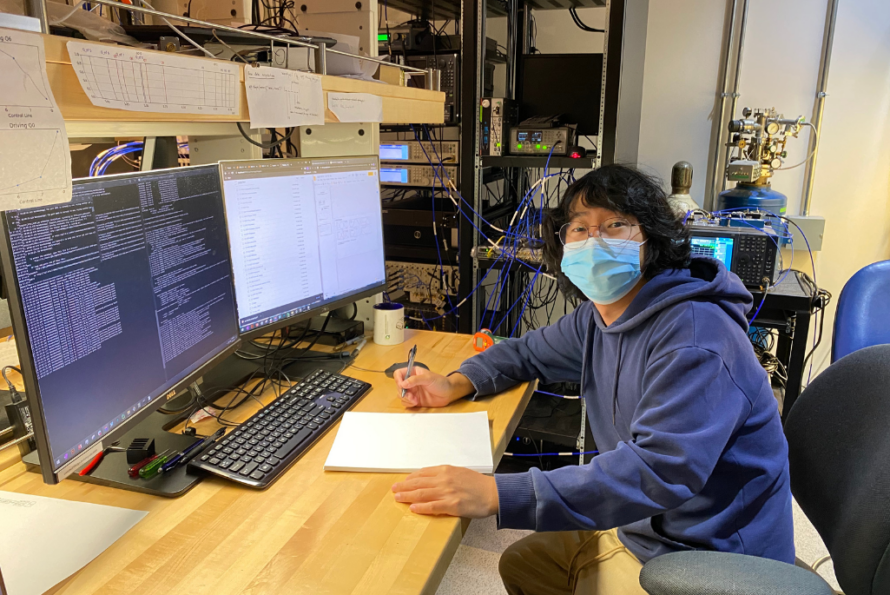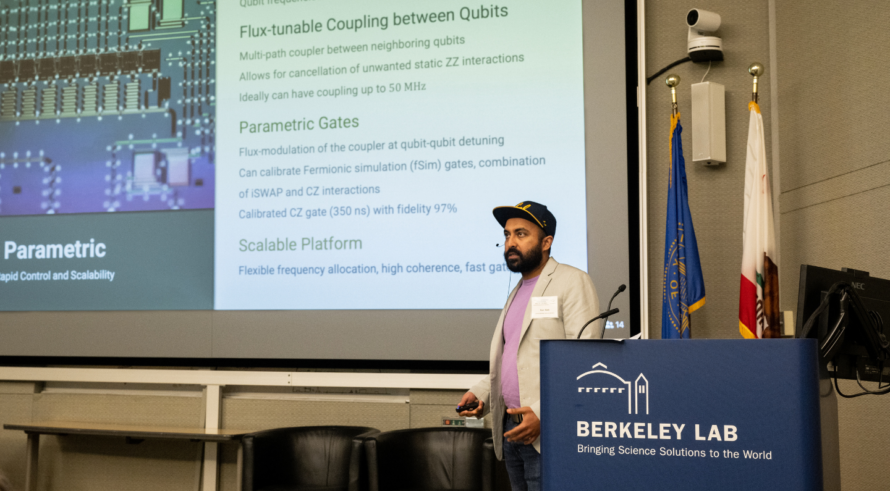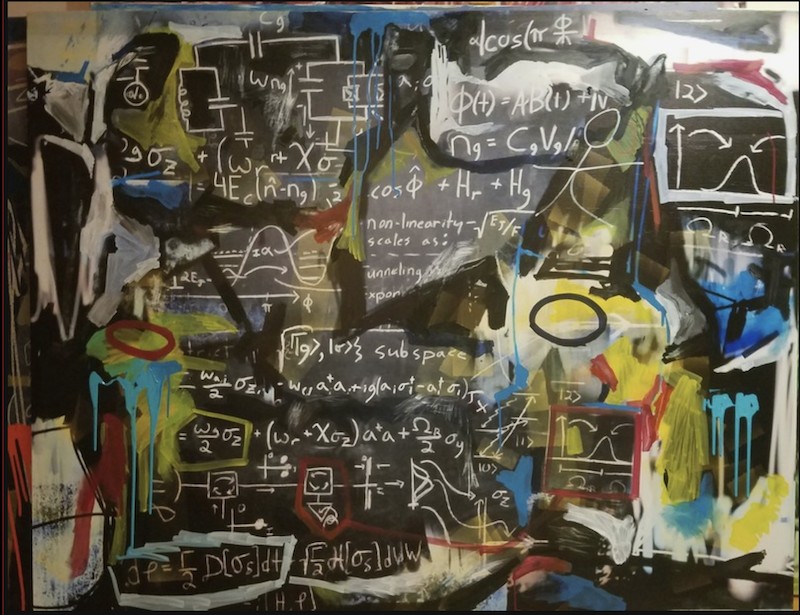This article is also available in Spanish
The latest experimental advances in quantum information science (QIS) and technology have opened new opportunities for fundamental scientific discovery and novel technology development. These breakthroughs have also broadened the field’s need for an increasingly quantum-ready workforce capable of collaborating, innovating, and harnessing the potential of next-generation quantum devices and technologies. As the field of QIS and technology evolves, bringing together experts in computer science, physics, engineering, materials science, and many other fields, contemporary visual art has also recently taken inspiration from the interdisciplinarity of QIS and added humanities into the mix.
California-based contemporary visual artist Benjamin Arizmendi collaborated with the Advanced Quantum Testbed (AQT) at Lawrence Berkeley National Laboratory (Berkeley Lab). Arizmendi created a series of mixed-media abstract pieces on wood and metal using QIS theory, schematics, and formulas working jointly with AQT’s team. AQT is a state-of-the-art research laboratory advancing quantum computing based on superconducting circuits, one of the leading technologies. In its fifth year of operations, AQT also operates an open-access experimental testbed for deep collaboration with external users from academia, National Laboratories, and industry. These interdisciplinary explorations with users at AQT inspired the novel work with Arizmendi.

Arizmendi began visits to AQT shortly after its launch in 2018 and has often conferred with AQT leadership and staff about the big open questions in quantum computing and physics, producing a series of mixed media paintings. AQT’s research and development has directly inspired three mixed pieces: Subjective Superposition Lab 1, Evasive Conductivity, and In Search of Symmetry. They portray the mathematical representation of complex fundamentals in QIS, such as superposition and entanglement, with stylized techniques and abstract designs. The paintings also include equations that describe the evolution and manipulation of quantum states for superconducting circuits. They are displayed in major computing research hubs – Berkeley Lab’s Shyh Wang Hall, also known as the computational research and theory building for numerous groups, including AQT and AQT’s lab at the University of California, Berkeley campus.
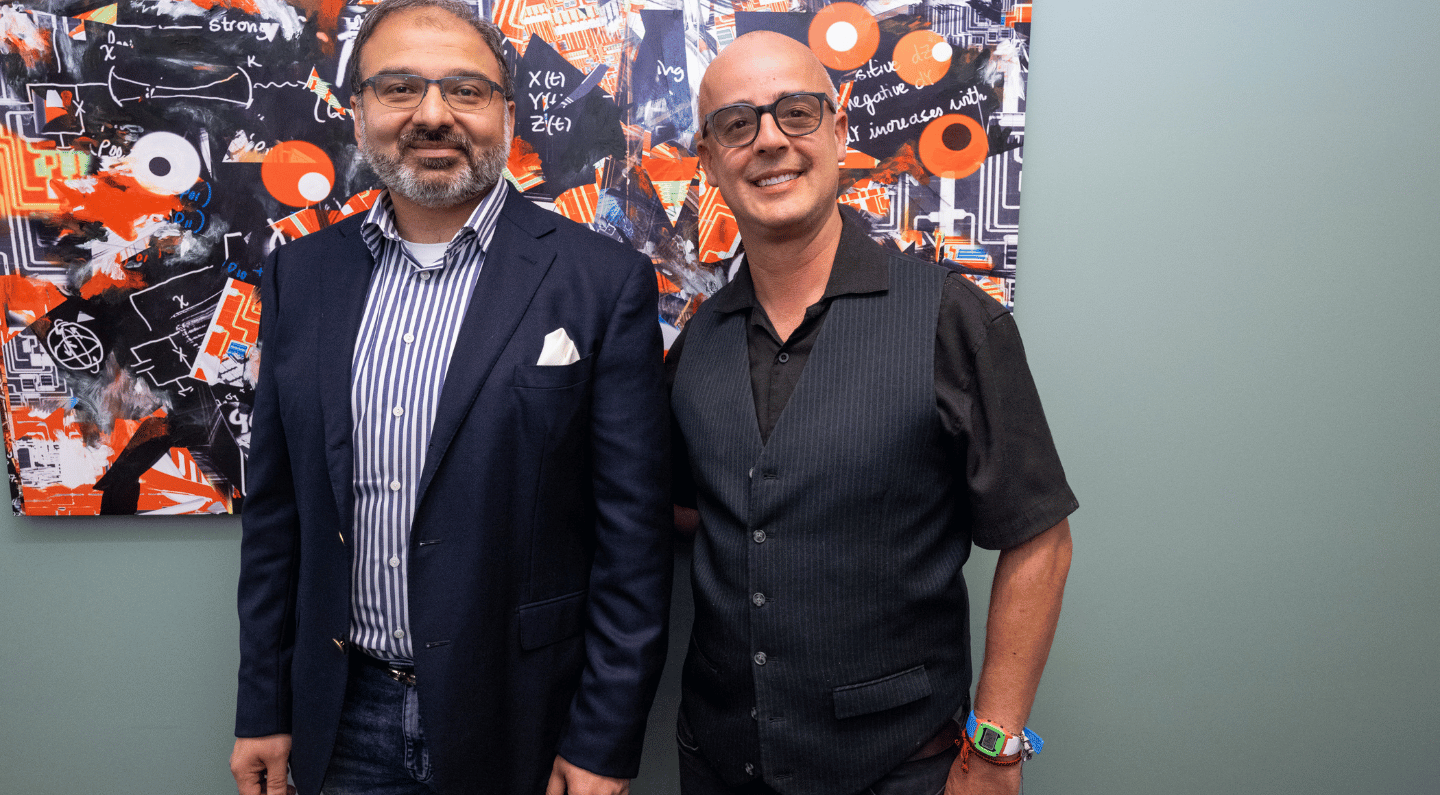
An Artist’s Lab
Hailing from Mexico City and an artistic family, Arizmendi pursued studies in philosophy and law in the United States. Then, after working for 15 years as an attorney and financial advisor, Arizmendi pivoted to a career as a full-time artist living many years in vibrant cosmopolitan cities such as Los Angeles, Washington, DC, and Boston. Much like his background, his artistic inspiration develops from the convergence of philosophical inquiry, abstract expressionism, photography, and digital media.
“Abstract art is a lot more free than traditional, representational art because we depart from objects and reality as we see it into a process of creativity and exploration, where art, much like scientific discovery, becomes a process of trial and error and coming up with new ideas,” said Arizmendi.
Quantum computing and physics are of particular interest to Arizmendi. There’s a profound philosophical and mathematical inquiry into the reality of nature at the tiniest of scales unseen by the eye with theories about macrophenomena in the universe. And thanks to these laws of physics, quantum devices process information and operate fundamentally differently than classical computation.
“I’m very enamored by mathematics, schematics, and philosophy, so I combine pictorial elements that are a part of the scientists’ world, including qubits, with color and materials into creative compositions,” explained Arizmendi.
The creative process for Arizmendi must be collaborative involving discussions about the types of questions researchers wrestle with, such as how to fabricate better qubits and pieces of quantum hardware or better understand the underlying theories.
Energizing QIS Research and Inspiring Curiosity
The artistic collaboration with Arizmendi has opened new discussion channels at AQT and Berkeley Lab about creative ways to energize and broaden QIS research by displaying vivid, abstract art in the science labs. Inspiring curiosity in humanities among the research community and vice versa may support a growing workforce seeking alternative approaches to research, development, discovery, and applications in a growing field with many open questions.
The creative arts may also serve as a communications vehicle to break down barriers across cultural contexts and languages, reaching different communities that wouldn’t have otherwise considered learning about QIS. The art at AQT shows how different communities can inspire and be inspired by QIS, making a quantum-ready vision mainstream.
Continue reading about Arizmendi’s work on World Quantum Day.
On #WorldQuantumDay, we celebrated 🥳🎨art+science! Benjamin Arizmendi's “In Search Of Symmetry” uses #quantum theory from the Advanced Quantum Testbed (AQT) funded by @doescience. @BerkeleyLab Foundation supported artistic collab.➡️https://t.co/fefGVO0jR0#AQTatBerkeleyLab pic.twitter.com/SXteO4fBYZ
— Berkeley Lab Computing Sciences Area (@LBNLcs) April 19, 2023
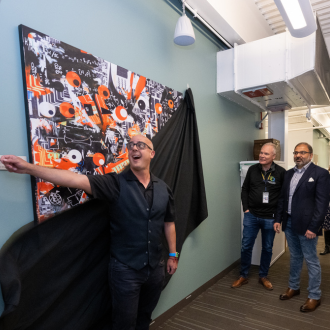
# # #
Founded in 1931 on the belief that the biggest scientific challenges are best addressed by teams, Lawrence Berkeley National Laboratory and its scientists have been recognized with 16 Nobel Prizes. Today, Berkeley Lab researchers develop sustainable energy and environmental solutions, create useful new materials, advance the frontiers of computing, and probe the mysteries of life, matter, and the universe. Scientists from around the world rely on the Lab’s facilities for their own discovery science. Berkeley Lab is a multiprogram national laboratory, managed by the University of California for the U.S. Department of Energy’s Office of Science.
DOE’s Office of Science is the single largest supporter of basic research in the physical sciences in the United States, and is working to address some of the most pressing challenges of our time. For more information, please visit energy.gov/science.
